Review and photos by Bokisaurus, edited by Suspsy
The family Proboscidea has a long and very diverse history. The group is perhaps most famous for their trunks and tusks, with some growing to astounding shapes and sizes. Today, only one family from this once mighty group remains: Elephantidae, consisting of only three species. When it comes to fame, one member of this group has clearly established itself as the undisputed king of fame, the woolly mammoth. But today, we will take a look at one of its distant relatives, one that is not as famous, but quickly gaining some attention, at least in the toy world. Meet the Gomphotherium. When it comes to toys, this species have at least been represented in the past. Bullyland made one way back in 1999 as part of their impressive lineup of prehistoric mammals. After a long absence from the spotlight, Gomphotherium is making a comeback. Today for this review, we will take a look at CollectA’s take on this odd-looking animal.
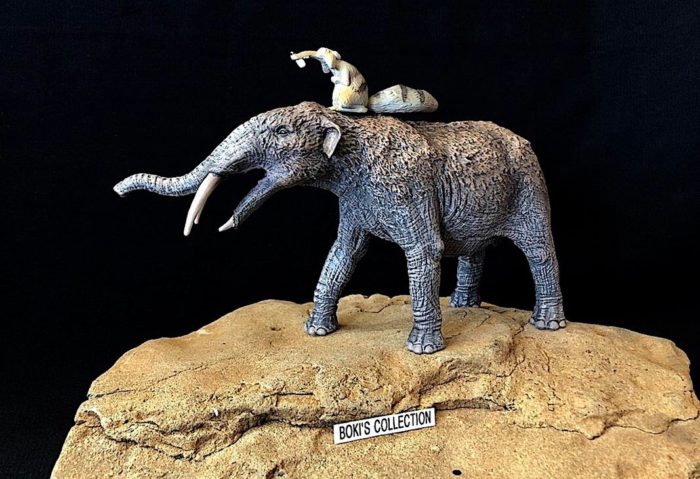
Gomphotherium evolved sometime during the early Miocene. As a species, it had a long run, lasting all the way through the early Pliocene. It was discovered in the 19th century and was named by Herman Burmeister in 1837. Its name means “welded beast.” It was also one of the most successful and widespread of all the prehistoric proboscideans. It is known from North America, Europe, and Africa.
In their long evolutionary history, the proboscidean family seems have tried every possible arrangement of tusks. From long and curving, to shovel-shaped, to dagger-like, to straight and short, it seems they have tried it all at various points in their history. This variation in tusk shape and size is what distinguishes the different species apart.
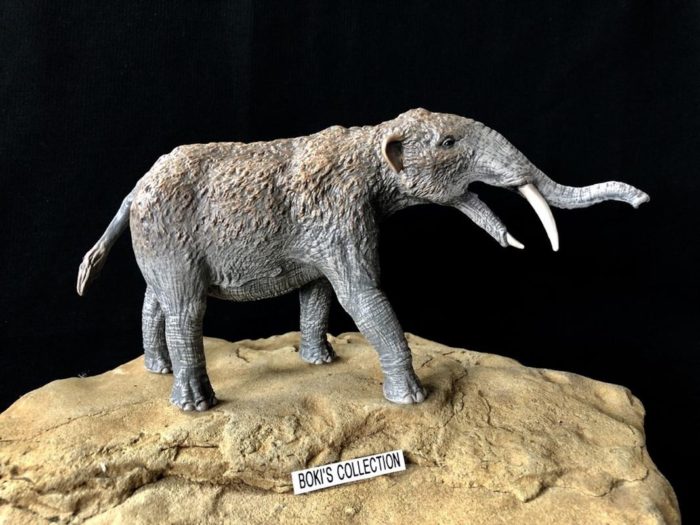
Gompotherium’s most distinctive features are indeed its odd-looking tusks, and not just two, but four of them. The two upper tusks are long, but instead of curving away from the body, this pair of tusks is recurved, which means that they curve inwards towards the body instead of away from it. The two lower tusks are small when compared to the upper ones.
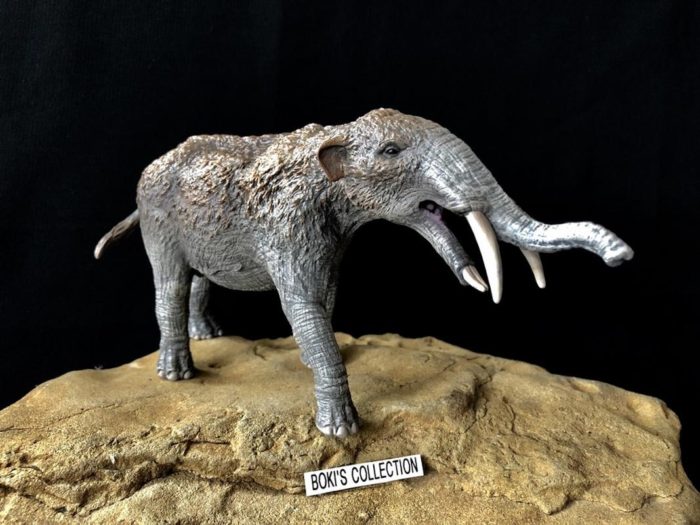
CollectA’s new Gompotherium, part of their 2018 lineup, is a beauty. It is the only prehistoric mammal from CollectA for this year. It’s a great species choice for them, and they did a great job with it. At first glance and if you cover the head, you would think that you are looking at an Asian elephant.
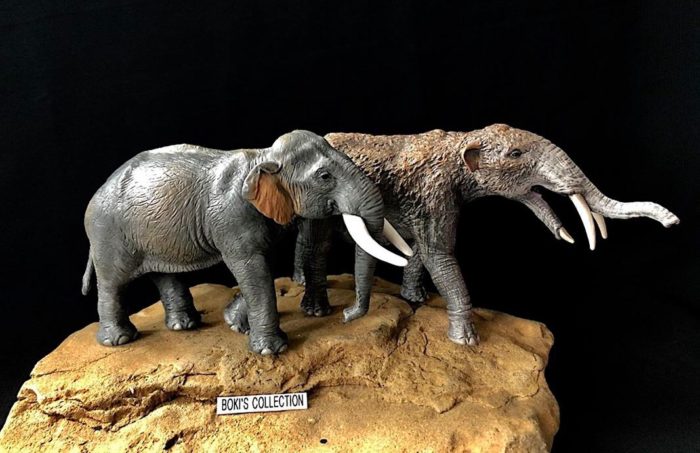
With its extant relative, the Asiatic elephant. Both are roughly the same scale.
The body is covered by sparse hairs, just like its extant relative. And just like the Asian elephant, these hairs do not cover the entire body, but are mostly concentrated on the upper half, growing thinner towards the lower half. The hairs are nicely sculpted, and they are highlighted with varying shades of brown and gray tones that contrast nicely with the overall grey body color. The body is rich in textures, from hairs to skin folds. There are great muscle definitions on the legs, back, and shoulders. And once again, it’s a male ( you can confirm that by looking between the legs). The figure is posed in mid-stride, with it’s right front leg forward. It looks relaxed, unlike the Deinotherium.
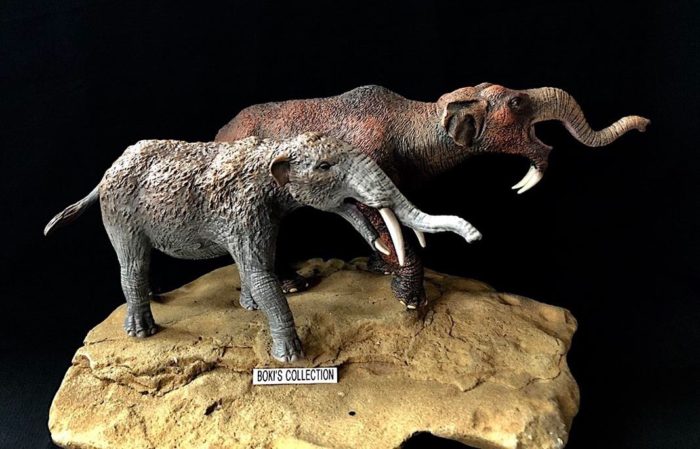
The head is nicely shaped. There are hairs, short ones, on the face, thinning out towards the base of the trunk. From here, it’s all skin, nicely detailed with lots of wrinkles and folds. The eyes are small and painted a simple black. The ears are small, very much like the Asian elephant’s. The trunk itself is not very long and is very well-proportioned and raised up as if the animal is sniffing the air. The large upper tusks are nice and have a dirty white color, with the base darker. This is appropriate since tusks are not pure white in real life. The mouth is open, and when you look inside, you can see teeth way back in there! This is something you don’t always see in figures, as they are often not that visible. You can tell a lot of care was put into producing this figure.
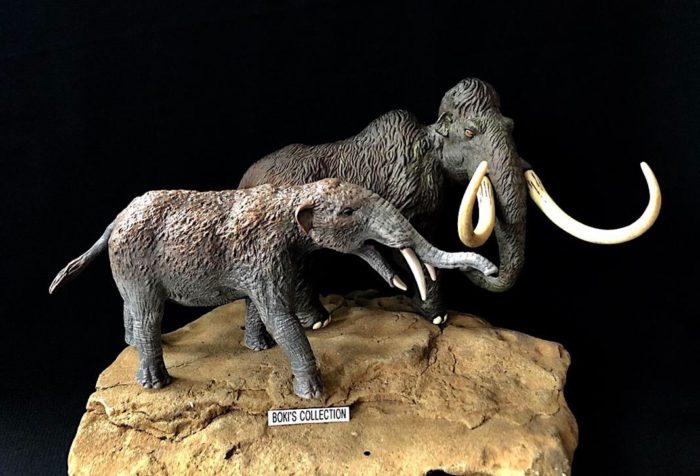
The lower jaw is narrow, as it should be. At the tip of the jaw, the lower, but much shorter tusks emerge. One look at this dentition design and you have to wonder how on earth did the animal grab its food. There are many theorie as to how the animal used its tusks. Gomphotherium is often associated with wetter environments, often in areas where there are bodies of water. It is believed that in this landscape, Gompotherium uses its tusks to dig up and uproot vegetation. The softer ground found in these ecosystems makes this form of eating and food gathering much easier than in dry and arid areas. As for the size, Gomphotherium averaged roughly around nine feet tall at the shoulders and fifteen feet long and weighing in at four tons. This make it about the same size as the Asian elephant.
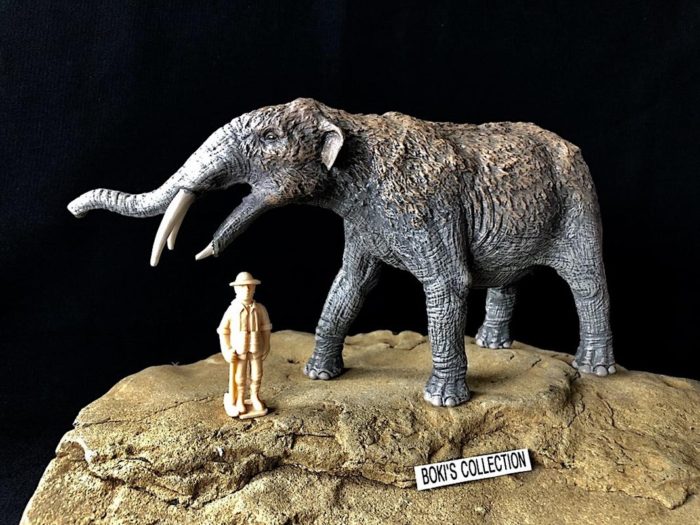
The figure measures nine inches long from trunk tip to tail tip, and four inches tall at the highest point (the top of head). It scales nicely with the other prehistoric mammals from CollectA, as well as some of the extant elephants from the major brands. Although Gomphotherium was one of the most successful of all prehistoric proboscideans, radiating across the globe and existing for million of years from the Early Miocene to the Early Pliocene, it did eventually go extinct.
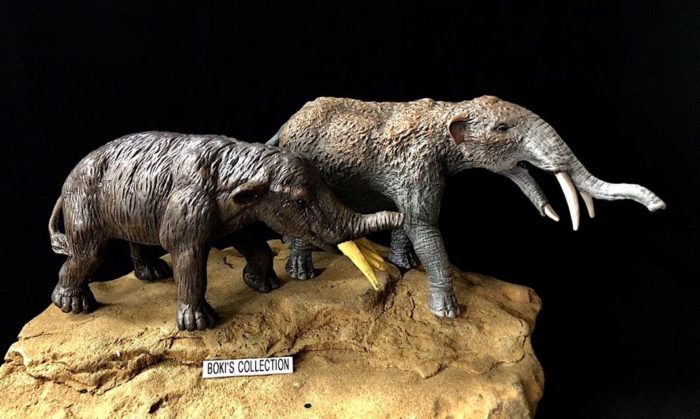
With Bullyland’s version.
Today, the last three surviving members of this mighty family, the Asian elephant, the African bush elephant, and the African forest elephant, are all threatened with extinction. Rapid increase in human populations around the world have pushed the remaining herds into smaller and smaller space, destroying what little habitat is left for these magnificent animals. The demand for ivory continues unabated. And to top it off, the changing climate worldwide has made it difficult to be optimistic about their future survival. Hopefully, the last three proboscideans won’t be joining the Gompotherium anytime soon.
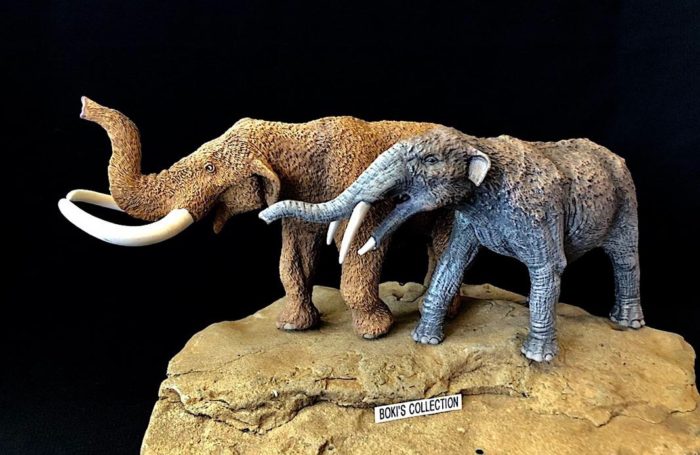
With the other prehistoric proboscidean from this year, Safari’s mastodon.
In closing, CollectA did a great job with this figure. It is the best one of the three produced so far. The figure is rich in details and accurate. Hopefully, CollectA continues with producing prehistoric proboscideans, as there are some truly cool-looking ones out there still begging to be made into toy form. For the prehistoric mammal fans, this is one figure that definitely deserves a space in your display shelf.
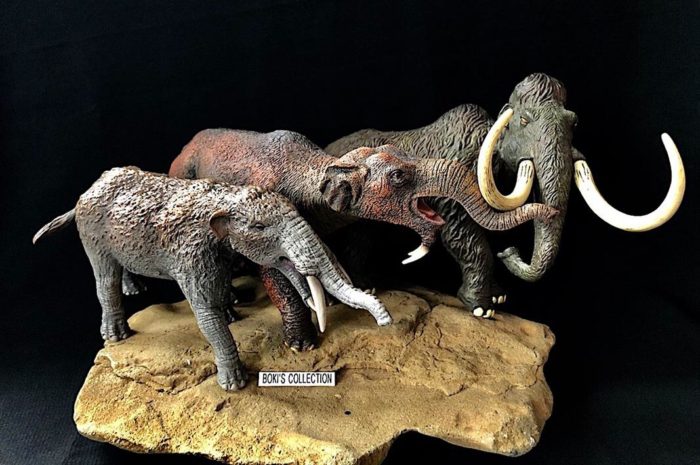
Hope you enjoyed the review, till next time, cheers!
Disclaimer: links to Ebay and Amazon on the DinoToyBlog are affiliate links, so we make a small commission if you use them. Thanks for supporting us!




Bokisaurus: After much research, I was able to discover a company that produces at least one species consisting of females primarily. The company is Mattel and the species is Homo sapiens, subspecies flava-comas (early blond(e) cave(man)). I am aware of Barbie, Skipper, Stacie, Chelsea, and Midge in their female line-up, but only one male, Ken, seems to have been brought to my attention thus far. Unlike the CollectA models, however, I find it more difficult to assign sex based on gross anatomical observation (at least that goes for Mattel’s sole male example in this series). Perhaps other companies will follow suit now that Mattel has blazed the trail for them.
Is there a known reason CollectA sculptors are so fond of animal testicles? You would think they would make the figures female once in a while.
Trust me, it’s not just CollectA sculptors who are/were fond of animal genatalia
I agree, it’s pretty much everyone.
I’m actually curious: does this figure have external testes? Because elephants do not, nor do most other afrotherians. Not that it wouldn’t be abundantly obvious that it’s a male even without.
Haha, no it doesn’t, but the orientation clearly makes it a male.
The real question is, with a few exceptions, can you name a company that produces mostly female animals, both extinct and extant?
The comparison shots seem to be a signature element that you use – they are hugely appreciated and very well done.
I concur!
I try, I always like to see the models with others.
Great review! Maybe its a trick of the lighting but the details look crisper on its left side than the right. Either way it still looks good.
Although it looks better in photographs than in the images of the toy exhibition and in the promotional image and put the best note five stars and as it says in this excellent publication Bokisaurus is a highly scientific figure in my case I prefer within my scientific ignorance plus the deinotherium of Collecta without ceasing to be a good figure but from my honest opinion I like more other figures of prehistoric animals and Collecta dinosaurs this year 2018 and for me in my complete paleontological ignorance is one of the less brilliant figures of Collecta.
It is a very good figure but I would really like a gomphotherium based on the paleoartistic works of Burian or the modern ones of Mauricio Antón and I say this with all due respect to the members of the forum and the sculptor Mathias Geiger.
Is Amebelodon an entirely different animal or is this an example of taxonomic change due to recent discovery? Wrt Burian above total concurrence! Love Baki’s reviews though I find they encourage me to spend too much. Thanks Rob
Fine review of a fabulous toy!